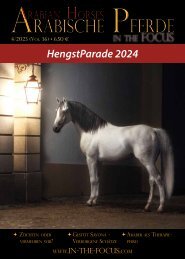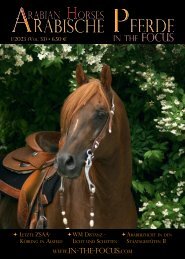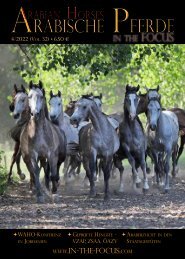Arabische Pferde IN THE FOCUS 4/2020 (Vol. 24) - public
Zeitschrift für Liebhaber und Züchter Arabischer Pferde
Zeitschrift für Liebhaber und Züchter Arabischer Pferde
Erfolgreiche ePaper selbst erstellen
Machen Sie aus Ihren PDF Publikationen ein blätterbares Flipbook mit unserer einzigartigen Google optimierten e-Paper Software.
ack with Captain Lessing. On the night of<br />
the 27th of April, he was returned to our<br />
lines by Lessing in a motorcycle side car<br />
– after some rather harrowing experiences<br />
behind the German line – for which he<br />
was decorated. He reported that all was<br />
arranged in Hostau – except for one Czech<br />
Lt. Colonel in the German army who opposed<br />
this – but had no support from the<br />
German officers.<br />
A small task force for the operation had already<br />
been formed from the 42nd Squadron<br />
– A Troop – elements of Troop C – a platoon<br />
of tanks from F Troop and a platoon<br />
of Troop E assault guns. All was under the<br />
command of Major Robert P. Andrews, with<br />
Captain Stewart as his assistant. At daylight<br />
all elements in the front line opened<br />
a fire fight – the Task Force broke through,<br />
and after some fighting at Bela Nad Radbuzou<br />
and a delay caused by an unmapped<br />
town showing up in their line of march, the<br />
town of Hostau was reached – no problem<br />
there – appeared as a fiesta rather than a<br />
battle. Townspeople and Allied prisoners of<br />
war lined the streets – the German soldiers<br />
presented arms – German flag went down –<br />
ours went up – and after placing outposts,<br />
the officers, intelligence personnel, and as<br />
many soldiers as could be spared, went to<br />
look at the wonderful array of captured<br />
horses.<br />
The horses captured consisted of about 300<br />
Lipizzaners, the Piber breeding herd plus<br />
the Royal Lipizzaner stud from Yugoslavia<br />
– well mixed together. Over one-hundred of<br />
the best Arabs in Europe, about two-hundred<br />
thoroughbred and trotting bred race<br />
horses collected from all of Europe – finally<br />
about 600 Cossack breeding horses – Don<br />
and Urals."<br />
Off to the USA<br />
The horses were not yet safe. On 30 April,<br />
the SS troops attempted to re-take Hostouň,<br />
but were soundly defeated. On 7 May,<br />
Germany surrendered, and Alois Podhajsky<br />
and the Spanish Riding School put on a<br />
performance for the American troops. General<br />
Patton was present. After the performance,<br />
Podhajsky, unaware of the events<br />
at Hostouň, asked Patton to find the Lipizzaner<br />
breeding stock and place them under<br />
U.S. protection, before they could fall into<br />
Russian hands, where they might very well<br />
4/<strong>2020</strong> - www.in-the-focus.com<br />
The Pure Polish Arabian<br />
be slaughtered to feed the hungry soldiers.<br />
Time was already running out to save the<br />
horses at Hostouň. Reed records that within<br />
a few days of Germany’s surrender, “the<br />
Czech and Russian communists were showing<br />
a great interest in the captured horses<br />
– in fact, they made several stealthy visits<br />
to Hostau, apparently to connive with the<br />
Czech born lieutenant colonel, who was<br />
second in command when we arrived.”<br />
Reed requested of Patton that the horses be<br />
moved to a safer location, in Bavaria, and<br />
so it was arranged.<br />
Roads were closed to ensure the horses’ swift<br />
and unimpeded escape. Very few trucks were<br />
available, but there were enough to ship<br />
mares heavy with foal, or with very young<br />
foals at foot. The rest of the horses had to<br />
walk. At dawn on 12 May, the first small<br />
bands of horses moved out, accompanied<br />
by outriders and guides drawn from the U.S.<br />
troops, the Germans, and some Cossacks<br />
who had fought with the Germans against<br />
the Soviets. All that day, horses streamed<br />
from Hostouň, shepherded by men on horseback<br />
and in vehicles, clattering down the<br />
roads, all the long miles to safety.<br />
Podhajsky was flown up to see the horses on<br />
14 May, and less than a month after Colonel<br />
Reed’s fateful breakfast, the Piber Lipizzaner<br />
breeding herd was home once more.<br />
However, the Polish Arabians had a longer<br />
journey ahead of them. First they were sent<br />
to a German remount depot, where the<br />
Americans picked them over, selecting the<br />
best of them as booty. These they shipped<br />
back to the U.S., amongst them Witez II and<br />
his half-sister Wierna, two of the finest of<br />
Ofir’s offspring. The Poles protested this<br />
latest theft of their horses, but to no avail.<br />
In America, the Polish horses crossed very<br />
well with the local Arabians, and many of<br />
the champion show horses in the years to<br />
come would have a Polish parent or grandparent,<br />
sparking U.S. interest in the Polish<br />
horses, and changing the course of Arabian<br />
breeding in the United States.<br />
Survival against all odds<br />
However, in Poland, the private studs had<br />
been scattered, their horses lost. Janów<br />
Podlaski’s herd had been sadly diminished<br />
by the ravages of the war as well. With Poland<br />
under the control of Soviet Russia, the<br />
old aristocracy had to flee. Prince Roman<br />
After all this history of Arabian breeding in Poland and its remarkable survival against all<br />
odds, it may come as a surprise that the term Pure Polish is not actually Polish in origin, but<br />
was instead hammered out by U.S. Polish Arabian enthusiasts. For a horse to be Pure Polish,<br />
it must trace entirely back to horses entered into the Polish studbook compiled in 1929 and<br />
must be registered in the Polish studbook. New blood can only be introduced by the state<br />
studs, and even then it only counts as Pure Polish if the horse is imported into Poland, registered<br />
in the stud book, and used by a state stud. The horses bred prior to the First World War<br />
are automatically Pure Polish as well, though their current descendants must meet the other<br />
criteria, hence the sons and daughters of Skowronek bred at Crabbet are not Pure Polish,<br />
even though their sire Skowronek is.<br />
71<br />
Władysław Sanguszko escaped to Brazil,<br />
but his precious herd at Gumniska, the<br />
last of the great Sanguszko studs, was lost<br />
when evacuating in the face of the Russian<br />
advance: they may have been captured and<br />
slaughtered by Soviet soldiers. For Szeikha,<br />
the Pearl of Arabia, who had crossed 175<br />
miles of desert without water, this was her<br />
final flight. Her daughters Udzda and Abra<br />
were lost as well. All that remained of the<br />
Gumniska horses were a handful of youngsters,<br />
including the granddaughter of Szeikha,<br />
Ferha, who combined the blood of<br />
three of Ziętarski’s desert imports, the two<br />
stallions Kuhailan Kruszan and Kuhailan<br />
Zaid, and Szeikha herself.<br />
After the war, all surviving purebred Arabians<br />
that could be found were rounded<br />
up and transferred to the ownership of<br />
the state. The era of the great aristocratic<br />
breeders was done for good, and it would<br />
be some time yet before private breeding<br />
started up again. In 1946, there were just<br />
fifty-two broodmares in Poland; in 1951 a<br />
further fourteen mares were imported from<br />
Bábolna. Janów Podlaski had been badly<br />
damaged in the course of the war, and the<br />
horses could not return there until it had<br />
been restored. Instead, three separate state<br />
studs were created, Albigowa, Nowy Dwór,<br />
and Michalów, though Albigowa and Nowy<br />
Dwór were only temporary, and in 1960 the<br />
horses from these studs were returned to<br />
Janów.<br />
During the post-war period, the Polish Arabian<br />
naming traditions underwent yet another<br />
shift. In the days of the Sanguszkos,<br />
Branickis, and Dzieduszyckis, each stud<br />
had had its own naming tradition. The<br />
Branickis tended to give their foals names<br />
beginning with the same letter as that of<br />
their sire, while from the 1860s on the Sanguszkos<br />
gave each year’s cohort of foals<br />
names beginning with the same letter, so<br />
the R cohort was 1876, the S cohort 1877,<br />
and so on. At Janów Podlaski, the Sanguszko<br />
approach was adopted, hence Ofir’s first<br />
crop of foals all having names beginning<br />
with W. After the Second World War, the<br />
tradition was briefly reinstated, but in 1950<br />
Albigowa broke with this tradition, giving<br />
foals names that began with the same letter<br />
as that of their dam, and in the next two<br />
years the other two studs followed suit. So<br />
now Polish mare families are usually referred<br />
to by their initial, e.g. the E family<br />
(the most famous E family is that descending<br />
from the c. 1810 mare Milordka, with<br />
two branches tracing to Ela and Estokada),<br />
or the P family (which descends from the c.<br />
1840 mare Szamrajówka via Piewica).<br />
The Polish Arabian is held in high regard to<br />
this day. It comes close to a miracle how he<br />
survived the devastation of the two world<br />
wars and rose like a phoenix from the ashes<br />
more than two hundred years after Hieronimus<br />
Sanguszko's first expedition into the<br />
Syrian desert, beautiful and resilient.<br />
Kate McLachlan<br />
History
















